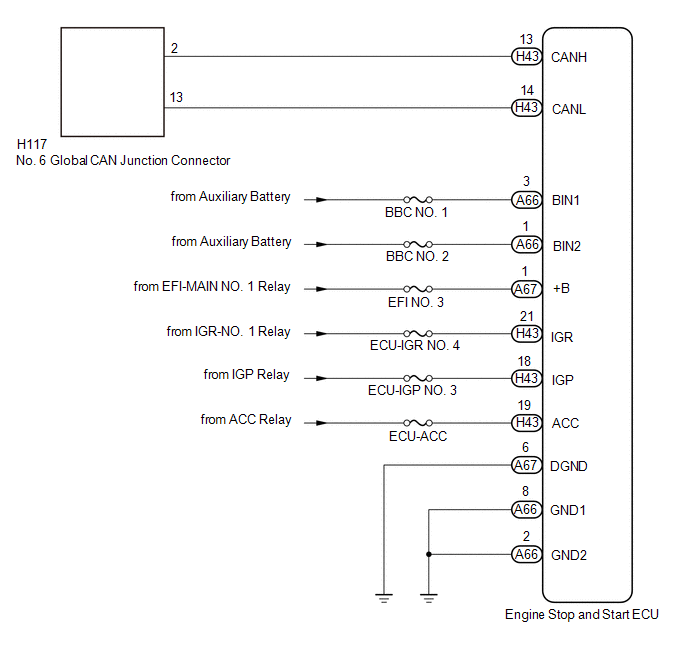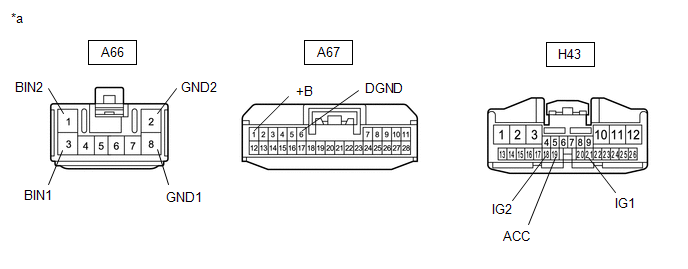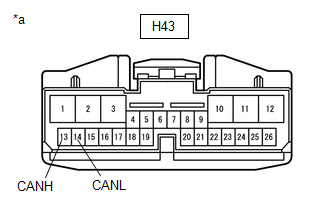Toyota Yaris: Can Communication System / Engine Stop and Start ECU Communication Stop Mode
DESCRIPTION
| Detection Item | Symptom | Trouble Area |
|---|---|---|
| Engine Stop and Start ECU Communication Stop Mode | Communication stop for "Stop and Go/Start" is indicated on the "Communication Bus Check" screen of the GTS. Click here
|
|
WIRING DIAGRAM

CAUTION / NOTICE / HINT
CAUTION:
When performing the confirmation driving pattern, obey all speed limits and traffic laws.
NOTICE:
-
Because the order of diagnosis is important to allow correct diagnosis, make sure to begin troubleshooting using How to Proceed with Troubleshooting when CAN communication system related DTCs are output.
Click here

- Before measuring the resistance of the CAN bus, turn the engine switch off and leave the vehicle for 1 minute or more without operating the key or any switches, or opening or closing the doors. After that, disconnect the cable from the negative (-) auxiliary battery terminal and leave the vehicle for 1 minute or more before measuring the resistance.
-
After the ignition switch is turned off, there may be a waiting time before disconnecting the negative (-) auxiliary battery terminal.
Click here

-
When disconnecting and reconnecting the auxiliary battery, there is an automatic learning function that completes learning when the respective system is used.
Click here

-
Some parts must be initialized and set when replacing or removing and installing parts.
Click here

-
After performing repairs, perform the DTC check procedure and confirm that the DTCs are not output again.
DTC check procedure: Turn the ignition switch to ON and wait for 1 minute or more. Then operate the suspected malfunctioning system and drive the vehicle at 60 km/h (37 mph) or more for 5 minutes or more.
-
After the repair, perform the CAN bus check and check that all the ECUs and sensors connected to the CAN communication system are displayed as normal.
Click here

- Inspect the fuses for circuits related to this system before performing the following procedure.
HINT:
- Before disconnecting related connectors for inspection, push in on each connector body to check that the connector is not loose or disconnected.
- When a connector is disconnected, check that the terminals and connector body are not cracked, deformed or corroded.
PROCEDURE
| 1. | CHECK FOR OPEN IN CAN BUS LINES (ENGINE STOP AND START ECU BRANCH LINE) |
(a) Disconnect the cable from the negative (-) auxiliary battery terminal.
(b) Disconnect the engine stop and start ECU connector.
| (c) Measure the resistance according to the value(s) in the table below. Standard Resistance:
|
|
| NG |
 | REPAIR OR REPLACE CAN BRANCH LINES OR CONNECTOR (ENGINE STOP AND START ECU) |
|
| 2. | CHECK HARNESS AND CONNECTOR (POWER SOURCE CIRCUIT) |
(a) Disconnect the engine stop and start ECU connectors.
(b) Measure the resistance according to the value(s) in the table below.

| *a | Front view of wire harness connector (to Engine Stop and Start ECU) | - | - |
Standard Resistance:
| Tester Connection | Condition | Specified Condition |
|---|---|---|
| A66-8 (GND1) - Body ground | Cable disconnected from negative (-) auxiliary battery terminal | Below 1 Ω |
| A66-2 (GND2) - Body ground | Cable disconnected from negative (-) auxiliary battery terminal | Below 1 Ω |
| A67-6 (DGND) - Body ground | Cable disconnected from negative (-) auxiliary battery terminal | Below 1 Ω |
(c) Reconnect the cable to the negative (-) auxiliary battery terminal.
(d) Measure the voltage according to the value(s) in the table below.
Standard Voltage:
| Tester Connection | Condition | Specified Condition |
|---|---|---|
| A66-3 (BIN1) - Body ground | Always | 9.5 to 14 V |
| A66-1 (BIN2) - Body ground | Always | 9.5 to 14 V |
| A67-1 (+B) - Body ground | Ignition switch ON | 9.5 to 14 V |
| H43-21 (IGR) - Body ground | Ignition switch ON | 9.5 to 14 V |
| H43-18 (IGP) - Body ground | Ignition switch ON | 9.5 to 14 V |
| H43-19 (ACC) - Body ground | Ignition switch ACC | 9.5 to 14 V |
| OK |
 | REPLACE ENGINE STOP AND START ECU |
| NG |
 | REPAIR OR REPLACE HARNESS OR CONNECTOR (POWER SOURCE CIRCUIT) |
 Center Airbag Sensor Communication Stop Mode
Center Airbag Sensor Communication Stop Mode
DESCRIPTION Detection Item Symptom Trouble Area Center Airbag Sensor Communication Stop Mode Communication stop for "Airbag" is indicated on the "Communication Bus Check" screen of the GTS...
 4WD Control ECU Communication Stop Mode
4WD Control ECU Communication Stop Mode
DESCRIPTION Detection Item Symptom Trouble Area 4WD Control ECU Communication Stop Mode Communication stop for "Four Wheel Drive Control" is indicated on the "Communication Bus Check" screen of the GTS...
Other information:
Toyota Yaris XP210 (2020-2026) Reapir and Service Manual: Removal
REMOVAL CAUTION / NOTICE / HINT CAUTION: Never perform work on fuel system components near any possible ignition sources. Vaporized fuel could ignite, resulting in a serious accident. Do not perform work on fuel system components without first disconnecting the cable from the negative (-) auxiliary battery terminal...
Toyota Yaris XP210 (2020-2026) Reapir and Service Manual: Vacuum Sensor
ComponentsCOMPONENTS ILLUSTRATION *1 E.F.I. VACUUM SENSOR ASSEMBLY *2 VACUUM HOSE *3 NO. 1 ENGINE COVER SUB-ASSEMBLY - - N*m (kgf*cm, ft.*lbf): Specified torque - - On-vehicle InspectionON-VEHICLE INSPECTION PROCEDURE 1...
Categories
- Manuals Home
- Toyota Yaris Owners Manual
- Toyota Yaris Service Manual
- Engine & Hybrid System
- Adjustment
- How to connect USB port/Auxiliary jack
- New on site
- Most important about car
Front Seat Belt Pretensioners
The front seat belt pretensioners are designed to deploy in moderate or severe frontal, near frontal collisions.
In addition, the pretensioners operate when a side collision or a rollover accident is detected. The pretensioners operate differently depending on what types of air bags are equipped. For more details about the seat belt pretensioner operation, refer to the SRS Air Bag Deployment Criteria.



